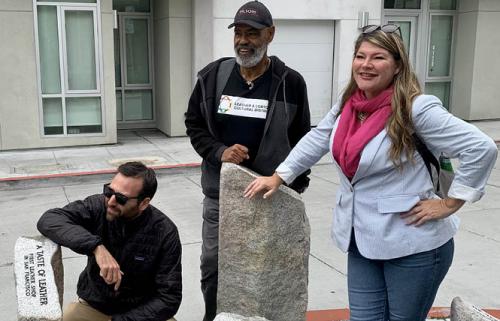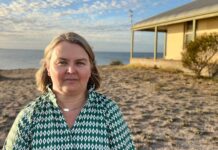The former offices for Drummer magazine and the LGBTQ newspaper the Sentinel at 285 Shipley Street would receive one. So, too, would the location of the early gay and lesbian rights organization the Society for Individual Rights, commonly known as SIR, at 83 Sixth Street.
Another would be installed at 54 10th Street, once home to the San Francisco AIDS Foundation. And one would be found at 947 Folsom Street, where the adult bookstore Folsom Gulch, known for its cruisy video arcade, operates.
The quartet of addresses in San Francisco’s South of Market district are slated to one day receive bronze plaques embedded in the sidewalk honoring the LGBTQ-owned businesses and organizations that have called the sites home. It is part of a project dubbed the Leather History Cruise that is creating a walking tour of the neighborhood’s current and former locations of gay bars, bathhouses, nightclubs, and other sites that played a role in making the area a world-famous leather and LGBTQ destination.
The Board of Supervisors last year approved installing sidewalk markers at 50 locations tied to San Francisco’s leather and LGBTQ culture in SOMA. At its October 18 meeting, the 11 members of the board unanimously voted to add another 46 sites to the list.
The first set of bronze plaques are to be installed as part of the streetscape improvement project underway along Folsom Street. The roadway had earned the nickname of the “Miracle Mile” because of how many gay bars and bathhouses operated on or near it in the 1960s and 1970s.
But the onset of the AIDS epidemic in the 1980s soon would diminish SOMA’s leather scene. The health crisis resulted in most gay bathhouses and sex clubs in the area closing their doors.
The area went from having at least 40 LGBTQ venues, bars and businesses to just 11 today, according to the Leather & LGBTQ Cultural District. It is working with city officials to turn the history walk project in western SOMA into a reality.
“It will help commemorate the vibrant history of our community in SOMA,” Robert Goldfarb, a gay man who is executive director of the SOMA LGBTQ cultural district, told the supervisors’ land use and transportation committee earlier this month.
As the Bay Area Reporter previously reported, the committee had voted 3-0 October 3 in support of expanding the list of locations to be included on the leather walk. It coincided with the start of LGBTQ History Month.
Gay District 6 Supervisor Matt Dorsey, appointed in the spring to the seat that includes SOMA, sponsored the resolution. Gay District 8 Supervisor Rafael Mandelman signed on as a co-sponsor, as did all three members of the land use committee: chair Supervisor Myrna Melgar (District 7) and Supervisors Aaron Peskin (District 3) and Dean Preston (District 5).
The plaques project is just one of the initiatives the leather cultural district is working on in order to preserve western SOMA as an LGBTQ neighborhood and location for leather establishments.
“The leather and LGBTQ community has been established in SOMA since the mid-1960s and has experienced significant displacement through gentrification and redevelopment,” Bob Brown, president of the leather district’s board, had told the supervisors’ committee.
Saturday, October 15, Brown helped show off the San Francisco South of Market Leather History Alley to state Senator Ben Allen (D-Santa Monica) and Assemblymember Tasha Boerner-Horvath (D-Encinitas). They were in town visiting several of the city’s cultural districts, including the Transgender District in the Tenderloin neighborhood.
Located on Ringold Alley between Eighth and Ninth streets, the display about leather history debuted five years ago and recently received a refresh from the leather district. It sports bronze bootprints embedded in the sidewalk honoring various leather community leaders, some of whom owned the businesses to be memorialized with the bronze sidewalk markers.
The cultural district has collaborated on the sidewalk markers with the city’s arts commission, Public Works Department, and the San Francisco Municipal Transportation Agency. The estimated $120,000 price tag for the first plaques to be installed along Folsom Street is coming from local developers of projects in the area who are required to pay for community improvements as part of their permit approval process.
Their installation was included as part of the Folsom Streetscape Project and are to be among the final aspects of the project to be completed. The website for the project now has construction beginning in 2023.
As the B.A.R. first reported two years ago, such storied establishments as the Folsom Street Barracks, The Arena, Ramrod, The Brig, and the Club Baths of San Francisco are to be memorialized with historical markers, as well as the B.A.R.’s former SOMA locations. The paper’s longtime home at 395 Ninth Street next door to the Stud nightclub’s old location at the intersection of Ninth and Harrison streets was on the list of sites approved last year.
The paper’s other SOMA location at 1550 Howard Street is among those being added to the list this year. Another historic address is 1250 Folsom Street, which was the National Leather Association’s international headquarters.
The SOMA LGBTQ plaque project is similar to one undertaken several years ago by the Top of Broadway Community Benefit District in the city’s North Beach neighborhood. It has installed sidewalk markers at the site of historic businesses in the city’s Italian district, including a trio of LGBTQ nightlife spots shuttered decades ago.
“In a time when the queer community is under attack across the country and across the world, this sends a powerful statement that San Francisco stands in our support,” Cal Callahan, a gay man who is the leather district’s manager, said of having the supervisors’ support for the leather history walk.
A full list of the sites to be included on the history walk can be found here.
More information about the Leather & LGBTQ Cultural District can be found at its website.
Help keep the Bay Area Reporter going in these tough times. To support local, independent, LGBTQ journalism, consider becoming a BAR member.








